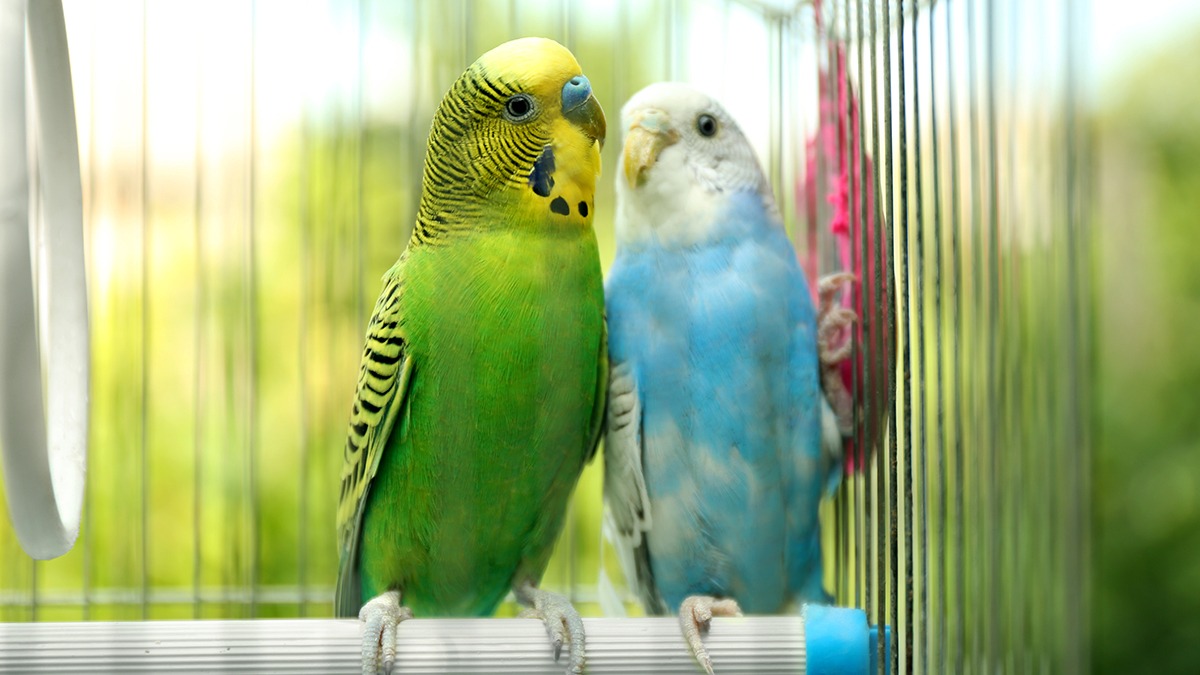
Species Overview
- Common Names: Budgerigar, Budgie, American English, or Parakeet
- Scientific Name: Melopsittacus undulatus
- Adult Size: 7.1 inches and weighs between 1.1 – 1.4 oz.
- Life Expectancy: 5 to 10 years, potentially more with great care
The budgie, or parakeet, is among the smallest of the parrot species commonly kept as pets. These small parrots are exceedingly friendly and easy to tame.
About Parakeets
Parakeet Pet Care: Cage Set-Up
- Parakeets are active and playful and should have a large cage that allows room for toys, sleeping, eating, and flight. A bigger cage is always better.
- A single bird can be excellent if you spend significant time interacting with them daily.
- Budgies seem to be happiest when kept in pairs so that they can entertain one another.
- Even if they have a large cage, budgies still need playtime and socialization opportunities outside of it.
- If you have concerns about controlling your bird’s flight area, consider trimming the wings to decrease the flying abilities.
- Your Parakeet’s cage should include at least two perches of different heights, thicknesses, and textures (including natural branches, if possible). These variations help keep your Parakeet’s feet healthy. Your bird should be able to move between the perches easily.
- Do not put perches over food or water dishes. The birds’ droppings will contaminate the food and water.
- Birds are sensitive to strong smells, smoke, and drafts. Keep your parakeet’s cage away from the kitchen and away from windows.
- Cushion the cage floor with a corncob layer, aspen, wood pellet, or recycled paper bedding, or use a liner.
- You’ll need to remove droppings frequently.
- Spot-clean the bottom liner or bedding weekly and replace it entirely once a month.
Parakeet Pet Care: Temperament
Budgies are gentle and docile birds. These small parrots are exceedingly friendly and easy to tame, mainly if acquired at a young age. Pairs of birds make good company for each other, but when in living pairs and entertaining one another, they may not bond as well with their owners or mimic speech as fluently. Budgies are also very playful, active, and quieter than some other types of parrots.
Origin and History
The budgie and other parakeet species are native to Australia, where they are found in huge flocks in grasslands. These wild species, however, are slightly smaller than the birds found in pet stores.
Speech and Vocalizations
While they can sometimes be challenging to understand, they are also quite capable of mimicking human speech.
Parakeet Pet Care: Diet and Nutrition
- Like other parrots, parakeets should be fed a variety of foods. Seeds can be a nutritious part of a budgie’s diet, but because they are high in fat, seeds should only make up a portion of the menu.
- A good pelleted bird food should be the basis of the diet. Pelleted diets are often the right choice for birds as they are nutritionally balanced, and birds can’t pick out their favorite seeds and leave the rest.
- To ensure your bird gets all the nutrients it needs, offer a variety of fresh vegetables (carrots, broccoli, corn, spinach, beans, etc.) and fruit. Try to rotate the kinds of fresh foods you offer.
- Your parakeet should always have access to a cuttlebone or mineral block. The cuttlebone helps to help keep their beaks healthy and provides calcium.
- Your parakeet must have fresh water at all times.
Exercise
Like all parrots, parakeets are active and playful. They’ll do best with plenty of interaction and playtime.
Your budgie needs a variety of toys to offer exercise and mental stimulation. It’s best to rotate the toys every month or so to prevent them from growing bored.
Free flying time is critical to the budgie; try to offer several hours each day in a room that is safe. A large houseplant can be a great playground.
Parakeet Pet Care: Healthcare
The vitamins and minerals found in fruits, vegetables, and a pellet-based diet are essential for maintaining your parakeet’s health. If you notice any of these signs of illness or distress, contact a veterinarian who treats birds:
- Decreased appetite or weight loss.
- Decreased activity or grooming.
- Feathers fluffed up for a long time.
- Long periods of sitting at the bottom of the enclosure.
- Sneezing.
- Discharge from nose or mouth.
- Change in droppings for more than two days.
Pet Safety
- Use caution when handling pets, and remember they may bite or scratch (especially when stressed).
- Supervise children around pets.
- ALL ANIMALS can potentially carry viral, bacterial, fungal, and parasitic diseases contagious to humans.
- Thoroughly wash your hands with warm, soapy water before and after contact with any pet or its habitat.
- Adults should assist children with handwashing after contact with a pet, its habitat, or aquarium water.
Pros
- Calm, gentle, even-tempered
- Quiet, suitable species for owners with close neighbors
- Can live with a few other bird species
Cons
- Requires 2 to 3 hours of exercise, mental stimulation, or a larger cage for horizontal flying needs
Related Searches
Bird Care